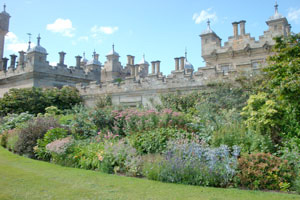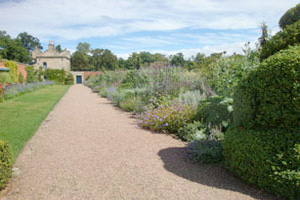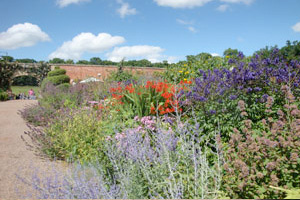Summer Travels in Scotland – Floors Castle
 Sandy Felton visits a romantic castle in the Borders famed for its walled garden and its splendid landscape views.
Sandy Felton visits a romantic castle in the Borders famed for its walled garden and its splendid landscape views.
During my summer Scottish trip this year I was fortunate enough to have time to visit Floors Castle. I say fortunate because Floors is one of Scotland’s great family seats and as such has the benefit not only of a beautiful garden but also an interesting house.
The house was built for the 1st Duke of Roxburghe in 1721 on a site which overlooks the River Tweed and the Cheviot Hills. Sir Walter Scott declared Floors to be ‘a kingdom for Oberon and Titania to dwell in’ – a fair description given the romantic rooftop line of the house and its setting. When Edinburgh architect, William Playfair, was commissioned in the 19th century to remodel the Georgian mansion – created by William Adam from an existing tower house – Playfair’s inspiration came not from the classical but from the highly ornamented picturesque style of Heriot’s Hospital in Edinburgh. The result is stunning and it is not surprising that the Duke and Duchess of the time were much pleased with the result of the alterations which took ten years between 1837 and 1847.
The house is a treasure trove and there are many fine examples of French furniture, porcelain and paintings. It has a lovely lived-in atmosphere and I think of all the houses I have visited over the years its charm and variety of contents makes it one of the most outstanding.
 The gardens and grounds at Floors originate from the formal design of William Adam with a less formal landscape evolving from the late 18th century. The 6th Duke was responsible for the creation of a new walled garden between 1857-60. This is one of the stars at Floors, with spectacular herbaceous borders, and a place where many of the great gardening traditions can be found.
The gardens and grounds at Floors originate from the formal design of William Adam with a less formal landscape evolving from the late 18th century. The 6th Duke was responsible for the creation of a new walled garden between 1857-60. This is one of the stars at Floors, with spectacular herbaceous borders, and a place where many of the great gardening traditions can be found.
There is a popular terrace café here and on a fine day you can sit outside and enjoy the splendours of the walled garden. This is where Queen Victoria took tea during her visit in 1867, and where you will find espalier fruit trees, topiary and traditional Scottish garden planting. You will find masses of grasses and campanulas, lupins and geraniums and the original Victorian iron poles, draped with swags of crimson rambling roses and purple clematis. Produce and flowers for the house are still grown here and it was obvious on the day of my visit that the garden centre is another big attraction with visitors.
The walled garden is away from the house, in fact quite a considerable distance, but the walk is pleasant and can be taken through woodland glades to bring you out by the Millennium Garden, featuring its parterre depicting the initials of the present Duke and Duchess. This area provides a formal contrast to the herbaceous borders in the walled garden next door and can be best viewed from the platform in the garden.
 You can take the Riverside Walk along the banks of the River Tweed where you might catch a glimpse of an oyster catcher, heron or green plover. There are trout and salmon and some lovely views.
You can take the Riverside Walk along the banks of the River Tweed where you might catch a glimpse of an oyster catcher, heron or green plover. There are trout and salmon and some lovely views.
In the parkland you will find some wonderful examples of Scottish native trees while the woodlands contain mature oak, lime trees and sweet chestnut, which survive from the time Daniel Defoe visited in the 18th century.
When I think of Floors I will remember the trees, so perfectly set in peaceful parkland, a place where you want to linger and enjoy natural beauty, a sense of peace and calm.
The grounds set the perfect backdrop to the stunning grandeur of the house where the formal lines of the 1st Duke’s house were continued out into the landscape with blocks of plantations creating Baroque avenues, still to be seen on the north front entrance to the castle while to the south the influence of late 18th century landscape gardening allows gentle views across to the Tweed.
Visitor information, opening times etc can be found at: www.floorscastle.com

